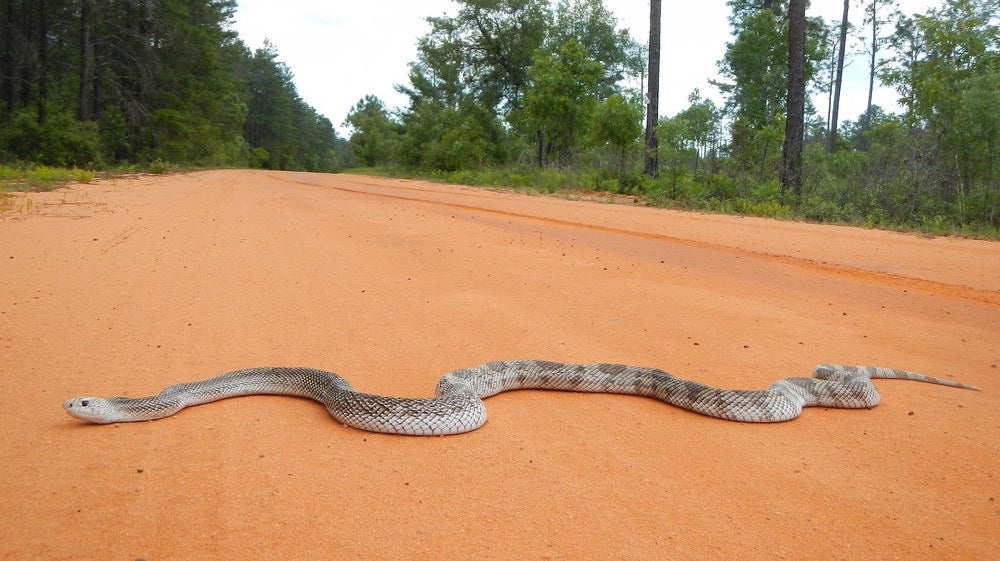How to Deal With Your Fear of Snakes

(Photo: MyFWC Florida Fish and Wildlife)
Editor’s Note: Backpacking can be scary. In this series, Fear Less, we address some common hiking phobias (and how to cope) so you can trek in confidence.
Always cast as the villain, snakes are one of the most feared creatures in the outdoors. No hiker wants to find one coiled next to the tree stump on which they are sitting or slithering alongside the trail. For many, snakes are fearsome reptiles to avoid at all costs.
Why are we so afraid of snakes? Most are harmless: Non-venomous (yes, it’s venomous, not poisonous; this means toxins are injected through biting or stinging) species outnumber venomous species five to one.
That said, most outdoor enthusiasts aren’t interested in taking time to pause and identify the snake bisecting the trail in front of them.
“There are evolutionary biologists who say it’s built into our psyche,” says William K. Hayes, professor of biology at Loma Linda University. The fear of snakes is as old as humankind itself, developed in a time when survival of the fittest meant avoiding anything and everything that could cause potential harm. This evolutionary fear has been passed down from generation to generation.
Studies have shown that the human brain recognizes and reacts to snake-like forms and shapes more quickly than other creatures of similar sizes or colors, even in photos. In short, humans will spot a snake in the grass a lot faster than a frog or caterpillar.
It’s also likely a learned fear: From infancy, the negative reactions of adults around us to threats like spiders and snakes subconsciously teach us to be afraid. Media plays a role, too: The reports we read of snakebites and near-death experiences tend to be sensationalized and over-publicized, which makes us believe snake encounters are not only a serious occurrence, but a common one. But this isn’t actually the case.
Fewer than 1 in 37,500 people are bitten by venomous snakes each year in the U.S., about 5,000 to 8,000 total. And of those occurrences, nearly half of them take place because the victim (usually males, who make up 80% of bite victims) was purposefully interacting with the snake.
Our fears of snakes aren’t totally unfounded, though. A bite from a venomous snake can be extremely serious, especially if you’re alone on a trail without access to emergency assistance. The symptoms and side effects that result from a bite from a venomous snake can cause nasty and permanent damage to joints, kidneys, even physical disfiguration. Then there’s the antivenom, which can cost up to $10,000 per vial (and most patients need between 14 and 70 vials).
Fortunately, fewer than five people in the U.S. die each year because of snakebites. It’s so rare, in fact, that you’re more likely to kick the bucket due to a spider bite or wasp sting than a snake bite.
No, snakes don’t deserve to be feared (after all, most are only defending themselves on the rare occasions they do lash out), but they should be respected. So when you’re hiking or backpacking in venomous snake territory (which could be just about anywhere in the continental U.S., but the most concentrated numbers tend to be in the south and southwestern states), learn what species to look out for and be wary. Don’t sit on a rock without checking your surroundings first, keep your distance when you do see a snake (most only have a strike distance equal to half their body length), and in areas where venomous species are known to be common, wear high-top boots and pants to help protect your ankles and lower legs.
If you do get bitten, don’t waste your time trying any of the home remedies for stopping the venom. Sucking or cutting the wound, using a tourniquet, or shocking the bite mark with a battery will do nothing to ease your pain or slow the spread of venom. The only cure for a venomous snakebite is to get to a hospital and get antivenom. So call for help, send a friend to the nearest trailhead, and do whatever you can to get to medical care as soon as possible. Bonus points if you’re able to safely snap a photo of the offending snake to help medical workers identify the species.
Don’t let a fear of snakes keep you from adventuring outdoors. Instead, learn about the reptiles, teach yourself how to identify the most dangerous species, and practice caution when hiking during warmer months. Remember, the outdoors are their home; you’re just visiting.